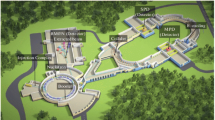Abstract
The ALICE experiment at the LHC is undergoing a major upgrade during the Long Shutdown 2 (2019–2021). In particular, the Time Projection Chamber (TPC) is being equipped with new GEM-based readout chambers and the readout electronics of several detectors are being replaced with faster and more flexible technology. This will allow ALICE to read out most of the detectors in the continuous mode and record minimum bias Pb–Pb events at rates of about 50 kHz in Run 3 (2021–2024) and Run 4 (2027–2030). The ALICE Collaboration is also considering the possibility to collect a large sample of proton–proton collisions at interaction rates of about 1 MHz using online and offline preselection of rare events. These goals require a completely new online computing system that will be used to perform fast reconstruction and compression of the data stream. The event selection strategy becomes especially challenging for the case of central diffractive events and ultra-peripheral Pb–Pb collisions characterized by rapidity gaps at forward and backward directions with only few tracks at central rapidity. In this contribution, the motivation for studying central diffractive and ultra-peripheral events is presented, and feasibility studies for their selection in Run 3 and 4 will be given.




Similar content being viewed by others
REFERENCES
K. Aamodt et al. (ALICE Collab.), “The ALICE experiment at the CERN LHC,” J. Instrum. 3, S08002 (2008).
P. Buncic, M. Krzewicki, and P. Vande Vyvre, “Technical design report for the upgrade of the online-offline computing system,” https://cds.cern.ch/record/2011297 (2015).
G. Eulisse, P. Konopka, M. Krzewicki, M. Richter, D. Rohr, and S. Wenzel, “Evolution of the ALICE software framework for Run 3,” EPJ Web Conf. 214, 05010 (2019).
D. Rohr et al. (ALICE Collab.), “Overview of online and offline reconstruction in ALICE for LHC Run 3,” arXiv:2009.07515 (2020).
Y. C. Pachmayer et al. (ALICE Collab.), “Future high-energy pp programme with ALICE,” https:// cds.cern.ch/record/2724925 (2020).
Z. Citron et al., “Report from Working Group 5: Future physics opportunities for high-density QCD at the LHC with heavy-ion and proton beams,” CERN Yellow Rep. Monogr. 7, 1159–1410 (2019); arXiv: 1812.06772
M. Aaboud et al. (ATLAS Collab.), “Evidence for light-by-light scattering in heavy-ion collisions with the ATLAS detector at the LHC,” Nat. Phys. 13, 852–858 (2017); arXiv:1702.01625.
A. Sirunyan et al. (CMS Collab.), “Evidence for light-by-light scattering and searches for axion-like particles in ultraperipheral PbPb collisions at \(\sqrt {{{s}_{{NN}}}} \) = 5.02 TeV,” Phys. Lett. B 797, 134826 (2019); arXiv:1810.04602.
J. R. Forshaw and D. A. Ross, Quantum Chromodynamics and the Pomeron (Cambridge Univ. Press, Cambridge, 1997).
V. Crede and C. Meyer, “The experimental status of glueballs,” Prog. Part. Nucl. Phys. 63, 74–116 (2009); arXiv:0812.0600 [hep-ex].
S. Donnachie, H. G. Dosch, O. Nachtmann, and P. Landshoff, Pomeron Physics and QCD (Cambridge Univ. Press, Cambridge, 2004) Vol. 19.
L. Adamczyk et al. (STAR Collab.), “Single spin asymmetry A N in polarized proton-proton elastic scattering at \(\sqrt {{{s}_{{NN}}}} \) = 200 GeV,” Phys. Lett. B 719, 62–69 (2013); arXiv:1206.1928 [nucl-ex].
C. Ewerz, M. Maniatis, and O. Nachtmann, “A model for soft high-energy scattering: Tensor pomeron and vector odderon,” Ann. Phys. 342, 31–77 (2014); arXiv: 1309.3478 [hep-ph].
C. Ewerz, P. Lebiedowicz, O. Nachtmann, and A. Szczurek, “Helicity in proton–proton elastic scattering and the spin structure of the pomeron,” Phys. Lett. B 763, 382–387 (2016); arXiv:1606.08067.
P. Azzi, in Report on the Physics at the HL-LHC, and Perspectives for the HE-LHC, Ed. by A. Dainese, M. Mangano, A. B. Meyer, A. Nisati, G, Salam, and M. A. Vesterinen (2019) (CERN Yellow Reports: Monographs; Vol. 7); arXiv:1902.04070.
E. Kryshen et al. (ALICE Collab.), “Recent ALICE results on coherent J/ψ photoproduction in ultra-peripheral Pb–Pb collisions,” PoSD IS2019, 0562019.
V. Guzey, E. Kryshen, M. Strikman, and M. Zhalov, “Evidence for nuclear gluon shadowing from the ALICE measurements of PbPb ultraperipheral exclusive J/ψ production, Phys. Lett. B 726, 290–295 (2013); arXiv: 1305.1724 [hep-ph].
V. Guzey, M. Strikman, and M. Zhalov, “Disentangling coherent and incoherent quasielastic J/ψ photoproduction on nuclei by neutron tagging in ultraperipheral ion collisions at the LHC,” Eur. Phys. J. C 74, 2942 (2014); arXiv:1312.6486 [hep-ph].
J. Contreras, “Gluon shadowing at small x from coherent J/ψ photoproduction data at energies available at the CERN Large Hadron Collider,” Phys. Rev. C 96, 015203 (2017); arXiv:1610.03350.
S. R. Klein, J. Nystrand, and R. Vogt, “Heavy quark photoproduction in ultraperipheral heavy ion collisions,” Phys. Rev. C 66, 044906 (2002); arXiv:hep-ph/0206220.
G. Aad et al. (ATLAS Collab.), “Measurement of light-by-light scattering and search for axion-like particles with 2.2 nb–1 of Pb–Pb data with the ATLAS detector,” arXiv:2008.05355 (2020).
Author information
Authors and Affiliations
Corresponding author
Ethics declarations
The author declares that he has no conflicts of interest.
Rights and permissions
About this article
Cite this article
Burmasov, N. Central Diffraction and Ultra-Peripheral Collisions in ALICE in Run 3 and 4. Phys. Part. Nuclei 53, 297–302 (2022). https://doi.org/10.1134/S106377962202023X
Received:
Revised:
Accepted:
Published:
Issue Date:
DOI: https://doi.org/10.1134/S106377962202023X




